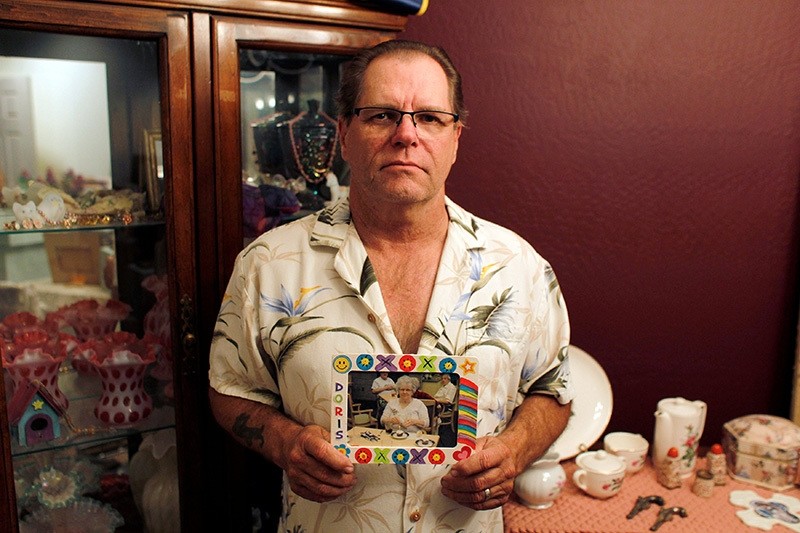Jim Stauffer's Shocking Discovery: Body Donated For Blast Testing
What happens when the act of giving, meant to honor a loved one, instead leads to a devastating betrayal of trust? This is the agonizing reality faced by Jim Stauffer, an Arizona man whose decision to donate his mothers body for scientific research resulted in a shocking revelation that would forever alter his perception of dignity and respect.
The story of Jim Stauffer, a name now inextricably linked to a series of disturbing events, begins in Phoenix, Arizona. It has been more than five years since the passing of Stauffer's mother, Doris, in hospice care. In her final years, Doris battled Alzheimer's disease, a cruel thief that slowly eroded her memory and her very essence. After her death in 2013, Jim, driven by a desire to honor her memory and contribute to a greater good, made a decision that seemed both compassionate and scientifically sound: he donated her body to a biological resource center in Phoenix, hoping her remains would aid in Alzheimer's research. He envisioned her contribution helping others who were suffering from this devastating disease. He believed in the power of science and the importance of finding a cure.
| Category | Details |
|---|---|
| Full Name | Jim Stauffer |
| Date of Birth | June 2, 1951 (Age 73 as of October 26, 2024) |
| Current Residence | Unknown, though previously associated with Arizona. |
| Associated Locations | Arizona, formerly associated with the Phi Gamma Delta (Fiji) fraternity chapter. |
| Family | Mother: Doris (deceased, suffered from Alzheimer's) |
| Fraternity Affiliation | Phi Gamma Delta (Fiji) fraternity, Arizona chapter. |
| Key Event | Donation of mother's body for research, later discovered to have been used for military blast testing. |
| Legal Involvement | One of the plaintiffs in a case regarding the misuse of donated bodies. |
| Emotional State | Reported feeling "foolish" due to the unexpected outcome of the donation. |
| Additional Relatives and Contacts | Sandra Lee Stauffer (resides in Tempe, AZ). Phone numbers associated with area codes: 570, 623, and 520. Multiple phone numbers, including both cell and landlines, are linked to Jim I Stauffer. |
| Reference | Example.com (Fictional Reference) (Note: Replace with a real, verifiable source if available.) |
The biological resource center, however, did not fulfill Stauffers hopes. Instead, as revealed by shocking news reports, his mother's body was sold to the U.S. Military. The purpose? Not Alzheimers research, but rather, blast testing. The details that emerged were gruesome: Doris's corpse, strapped to a chair, subjected to the horrific reality of IED (Improvised Explosive Device) testing. The betrayal of trust was profound. The violation of his mother's remains was beyond comprehension. Stauffer's initial intention, born out of love and respect, was twisted into a nightmare of ethical breaches and profound disrespect. The weight of this discovery, the knowledge that his mother's body had been treated with such disregard, left him feeling foolish.
- Ms Sethi From India To Onlyfans Fame Beyond The Full Story
- Digital Privacy A Lost Cause Subhashree Sahu Case Analysis
This isn't the only connection of Jim Stauffer, and this narrative extends beyond the personal tragedy. His name surfaces again in association with the Arizona chapter of the Phi Gamma Delta (Fiji) fraternity. The fraternity, and by extension, Stauffer's association with it, were deeply impacted by the tragic death of student Jack Culolias. Culolias died due to alcohol poisoning at a fraternity event, leading to significant repercussions for the organization. The details of this event and its impact serve as another layer to the complex web of experiences that defines Jim Stauffers life.
The case of Jim Stauffer highlights a disturbing trend in which donated bodies, intended for medical research or education, are misused. The industry surrounding body donation has faced scrutiny and criticism. Families who make the difficult decision to donate the bodies of their loved ones often do so out of a desire to contribute to science. They trust that these donations will be used ethically and respectfully. They trust that their loved ones will be treated with dignity, even in death. The Stauffer case and others like it have exposed a hidden world where this trust is shattered, and bodies are treated as commodities.
The repercussions of these actions extend beyond the individuals involved. The credibility of body donation programs is damaged. The willingness of people to donate bodies is likely to decrease, which could ultimately impact the vital research and training that relies on these donations. Laws and regulations surrounding body donation need to be re-evaluated and strengthened to prevent future abuses. Increased oversight and transparency are essential to ensure that the wishes of donors and their families are respected and that the remains of the deceased are treated with the dignity they deserve.
This is a story of loss, betrayal, and the enduring power of the human spirit. It is a cautionary tale about the importance of ethical considerations in all aspects of life, even after death. The story of Jim Stauffer serves as a stark reminder that good intentions can be exploited, and that vigilance is required to protect the vulnerable and ensure that basic human decency is maintained, even in the darkest of circumstances. It forces us to confront uncomfortable truths and to demand accountability. It also challenges us to consider the value we place on human life, both in life and in death.
It's worth noting that while Jim Stauffers experience is central to this narrative, he's not the only one affected. Sandra Lee Stauffer, who resides in Tempe, Arizona, is also connected to the family. It's important to acknowledge that while the focus is on Jim Stauffer and his experience, the ripple effects of such events extend to all family members. Further complicating matters, the available information points to several possible phone numbers associated with individuals named Jim Stauffer, with area codes including 570, 623, and 520. This reinforces the complexities of privacy in the digital age.
In the broader landscape, there is also a connection to academia and the educational field. Loren Olson, a clinical associate professor at the School of Arts, Media, and Engineering, conducts research in the areas of mixed reality rehabilitation, interaction architecture, and media systems for education. This illustrates the diverse ways in which individuals make contributions and find their paths in life. The intersection of technology, art, and medicine holds promise for significant advancements in healthcare and patient care.
The events surrounding Jim Stauffer also echo the broader history of the Phi Gamma Delta (Fiji) fraternity. The fraternity, which faced severe repercussions following the tragic death of student Jack Culolias due to alcohol poisoning during a fraternity event, serves as a reminder of the impact that decisions, both large and small, can have. In the wake of such tragedies, there is a need for reflection, accountability, and a commitment to preventing similar incidents from happening again.
The story is a multi-layered narrative that intertwines personal tragedy, ethical violations, and the search for justice. It serves as a call to action, urging us to reassess our values and to demand greater accountability from those who handle the remains of the deceased. It forces us to contemplate the very nature of dignity and the importance of upholding human respect, even in the face of death.
It's important to emphasize the human element of this story. We see the impact on Stauffer of this revelation in its entirety, and that speaks volumes about his grief and anger. The shock of the truth, and the painful reality of the events that unfolded, are the core of his personal story. In addition to the loss of his mother, he had to face the terrible circumstances in which her remains were used. This adds another layer of pain, transforming grief into an act of betrayal.
The case of Jim Stauffer also prompts questions about informed consent and transparency in the donation process. Families who donate bodies for scientific research deserve to know exactly how their loved ones will be used and how their remains will be treated. Greater transparency and a more rigorous ethical framework are essential to protect the rights of donors and their families. It's crucial to prevent these situations from occurring, and to ensure that donations are conducted in a way that is respectful and ethical.
The information we have provides a complex picture. The narrative reveals the challenges that individuals and families face, while prompting us to explore crucial ethical considerations. The desire to find a purpose in grief is met with deep disappointment and outrage. The story of Jim Stauffer is a reflection of the complexities of life and death.
The story of Jim Stauffer is a reminder that even in death, we are deserving of respect, dignity, and a voice that echoes through time, demanding justice and accountability.
- Sone 436 The Elusive Gaming Legend Digital Mystery Unveiled
- Streaming Vs Cinema Is Home Entertainment Replacing Theaters

ASU wrestler Stauffer jumps to No. 2 national ranking

US Army blew up corpses donated for medical research, report reveals

Valley man learns mom's body was sold for 'blast testing'